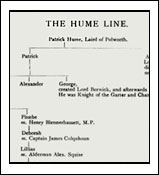 |

The Chittick Family History
as written by Erminda (Chittick) Rentoul
1890 The Lodge, Cliftonville, Belfast. Ireland
Chapter Nine | The Humes
 |
| The Hume Line |
| |
"The most noble and puissant Lord Alexander Hume, Earl
of Hume, Lord Hume, and Baron of Douglass. This family take
their surname from the castle of Hume in the Merse, or County
of Berwick, and derive their descent from William, second son
of Patrick, Earl of Dunbar, which William was succeeded by a
son of his name, who lived in the year 1268, and the family
after several descents became very powerful. In the reign of
King Robert III, Sir Thomas Hume of that ilk talking to wife
Nicholasa, heir of the family of Pedie, in the County of Berwick,
with her had the lordship of Douglass, and thereby his fortune
being much increased, he, in gratitude for that, added to his
paternal coat of arms, “Argent, three pipingoes, Vert,”
and by the said Nicholasa his wife had Alexander, his successor,
and David, Baron of Wedderburn."
“Duglass's Peerage
of Scotland” vol. I, page 731:-
Few families in Scotland can boast so high an origin as that
of Hume, being a branch of the great House of Dunbar, Earls
of Dunbar and March.
"Alexander, who succeeded, being a very warlike person
was taken prisoner by the English, and died a captive in England,
leaving a son of his name, which son distinguished himself
in the wars of France, and was there slain with the Earl of
Douglass at the Battle of Vemoil. He married a daughter of
the family of Hay of Yester, and by her had three sons, of
whom Sir Alexander, the eldest, who succeeded, raised the
glory and reputation of his family by the vast estate he acquired
both by marriage and otherwise, out of which he erected the
collegiate church of Dunglass; and he marrying to his first
wife Marjory, heiress of Landel in the County of Berwick,
by her had three sons; and by his second wife, who was daughter
to Alexander, Lord Montgomery, he had Thomas Hume, of Langshan,
in the County of Ayr."
In Hill's Plantation of Ulster-" Grants and Grantees,"
page 303, we find-
Sir John Home, of Hume
“This undertaker was a son of Alexander Home, of Manderston,
in Berwickshire, and brother of the well-known Sir George
Home, or Hume, who accompanied the King into England, and
in 1605 was created Earl of Dunbar."
“Sir George Hume is described as having been a person
of deep wit, few words, and in his Majesty's service no less
faithful than fortunate. The most difficult affairs he compassed
without any noise, never returning when he was employed, without
the work performed that he was sent to do."
In Burke's “Extinct Peerage," page 289, we find
"Sir John, the undertaker in Fermanagh, appears to have
migrated to London also. So early as August, 1603, when the
King had not been there many months, this Scotch borderer
obtained a license to export 1,000 deckers of red hides tanned
within two years. He soon afterwards obtained a pension of
L200 per annum, which he surrendered in1611 after he had got
his grant of lands in Fermanagh."-See Calendar of State
Papers, Domestic Series, James I. ; August 17,1603, and May
16, 1611."
In “Parliamentary Memoirs of Fermanagh," by the
Earl of Belmore,
1885, page 16, we find- Sir John Hume, or Home
"Patrick Hume, of Polworth, in Scotland, had two sons,
viz., Patrick, of Manderston, and Alexander, Lord Provost
of Edinburgh from 1593, who on the 15th October, 1591, obtained
a crown charter of the lands and barony of North Berwick.
His sister also was the prioress at North Berwick till her
death. Upon the death of Alexander in July, 1597, John, the
eldest son of Patrick, of Manderston, succeeded to the lands
(barony) of North Berwick, which were sold, July 1st, 1633,
to Sir William Dick, Sir John had two brothers, Alexander
and George, the latter having accompanied King James to England
was created an English peer, 7th July, 1604, as Lord Berwick.
He had been Treasurer of Scotland, and was on the 3rd July,
1604 further created Earl of Dunbar in the Scotch peerage;
be was also a Knight of the Garter, Chancellor of Exchequer,
and Master of the Wardrobe. “With his help his brothers,
Sir John and Alexander, had every opportunity of being forwarded
in their projects in connection with the Plantation of Ulster.
Pyner says, Sir John Hume hath 2,000 acres called Carrynroe.
To this Sir John Hume added by purchase in 1615 from William
Fuller, 1,500 acres called Moyglasse. In 1626 Sir John purchased
another small proportion estimated at 1,000 acres called Drumcose,
from his brother Alexander, the first patentee. Pyner, however,
in 1618 found this in the enjoyment of Sir John's eldest son,
George (the father of Phoebe, who married Henry Blennerhassett)."
"By the union of these three estates Sir John Hume became
the largest proprietor in the County Fermanagh. Sir John Hume
died 26th September 1639, and was succeeded by his son, George,
created a baronet in 1671. Sir George was succeeded by his
son, Sir John, who died in 1695, and was in turn succeeded
by his son, Sir Gustavus. The estates ultimately passed to
Mary, eldest daughter of Sir Gustavus Hume (by his wife Mary,
daughter of the Earl of Drogheda), who on the 18th August,
1739, married Nicholas, afterwards second Viscount Loftus
of Ely, and are now in the possession of the Marquis of Ely."
Chapters: < previous
| index | next
>
|






|



